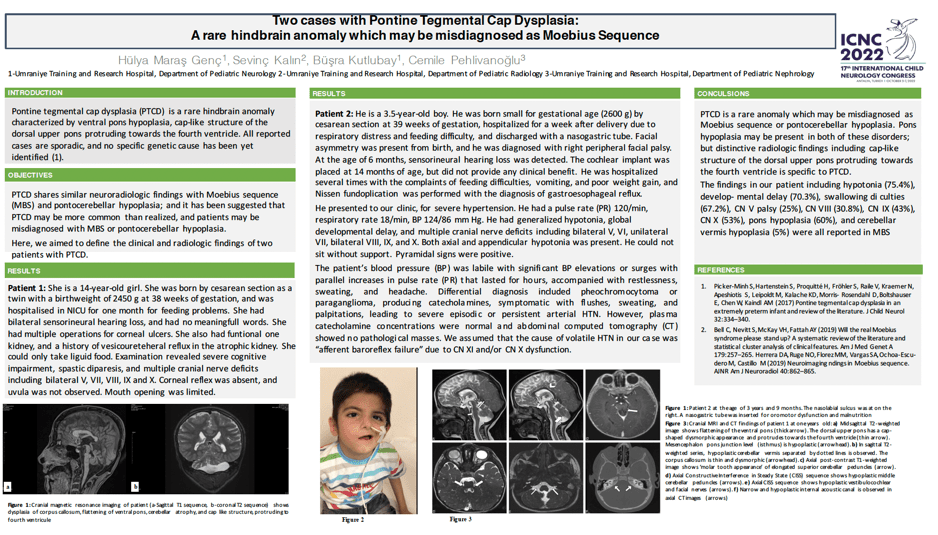Two cases with Pontine Tegmental Cap Dysplasia: a rare hindbrain anomaly which may be misdiagnosed as Moebius Sequence
Hülya Maraş Genç, Sevinç Kalın, Büşra Kutlubay, Cemile Pehlivanoğlu
Introduction: Pontine tegmental cap dysplasia (PTCD) is a rare hindbrain anomaly characterized by ventral pons hypoplasia, cap-like structure of the dorsal upper pons protruding towards the fourth ventricle. Here, we aimed to define the clinical and radiologic findings of two patients with PTCD. All reported cases are sporadic, and no specific genetic cause has been yet identified. Methods: Two patients with typical neuroradiologic findings of PTCD are described. Results: Patient 1 is a 3.5-year-old boy who has generalized hypotonia, global developmental delay, severe feeding difficulties necessitating gastrostomy tube, hypertension and multiple cranial nerve deficits including bilateral V, VI, unilateral VII, bilateral VIII, IX, and X. Patient 2 is a 14-year-old girl with severe cognitive impairment, spastic diparesis, feeding difficulty, operation history for corneal ulcers and multiple cranial nerve deficits including bilateral V, VII, VIII, IX and X. Both patients had ventral pons hypoplasia, cap-like structure protruding towards the fourth ventricle. Patient 1 had additional hypoplastic middle cerebellar peduncles, and abnormal shape of superior cerebellar peduncle with ‘molar tooth appearance’ (Figure 1). Discussion: PTCD is a rare anomaly which may be misdiagnosed as Moebius sequence or pontocerebellar hypoplasia. Pons hypoplasia may be present in both of these disorders; but distinctive radiologic findings including cap-like structure of the dorsal upper pons protruding towards the fourth ventricle is specific to PTCD.
Keywords: Pontine tegmental cap dysplasia, sensorineural hearing loss, facial palsy
Hülya Maraş Genç
Umraniye Training and Research Hospital
Turkey
Sevinç Kalın
Umraniye Training and Research Hospital
Turkey
Büşra Kutlubay
Umraniye Training and Research Hospital
Turkey
Cemile Pehlivanoğlu
Umraniye Training and Research Hospital
Turkey
Introduction: Pontine tegmental cap dysplasia (PTCD) is a rare hindbrain anomaly characterized by ventral pons hypoplasia, cap-like structure of the dorsal upper pons protruding towards the fourth ventricle. Here, we aimed to define the clinical and radiologic findings of two patients with PTCD. All reported cases are sporadic, and no specific genetic cause has been yet identified. Methods: Two patients with typical neuroradiologic findings of PTCD are described. Results: Patient 1 is a 3.5-year-old boy who has generalized hypotonia, global developmental delay, severe feeding difficulties necessitating gastrostomy tube, hypertension and multiple cranial nerve deficits including bilateral V, VI, unilateral VII, bilateral VIII, IX, and X. Patient 2 is a 14-year-old girl with severe cognitive impairment, spastic diparesis, feeding difficulty, operation history for corneal ulcers and multiple cranial nerve deficits including bilateral V, VII, VIII, IX and X. Both patients had ventral pons hypoplasia, cap-like structure protruding towards the fourth ventricle. Patient 1 had additional hypoplastic middle cerebellar peduncles, and abnormal shape of superior cerebellar peduncle with ‘molar tooth appearance’ (Figure 1). Discussion: PTCD is a rare anomaly which may be misdiagnosed as Moebius sequence or pontocerebellar hypoplasia. Pons hypoplasia may be present in both of these disorders; but distinctive radiologic findings including cap-like structure of the dorsal upper pons protruding towards the fourth ventricle is specific to PTCD.
Keywords: Pontine tegmental cap dysplasia, sensorineural hearing loss, facial palsy
Hülya Maraş Genç
Umraniye Training and Research Hospital
Turkey
Sevinç Kalın
Umraniye Training and Research Hospital
Turkey
Büşra Kutlubay
Umraniye Training and Research Hospital
Turkey
Cemile Pehlivanoğlu
Umraniye Training and Research Hospital
Turkey

Hülya Maraş Genç
Umraniye Training and Research Hospital Turkey
Umraniye Training and Research Hospital Turkey